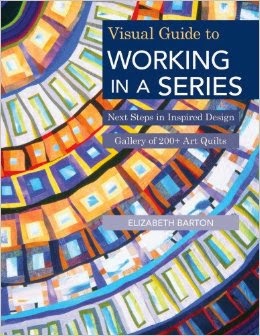 |
| the photo: York, UK. |
 |
| the quilt: cathedral |
Starting to make an art work with a photo is so looked down upon is because people often do a very bad job of it . Not only quilts! but paintings too.
They follow the photograph too closely (warts and all) and end up with an overly literal piece that shows the warts very well and not much else. This kind of work often looks exceeding stiff and lifeless. But I don’t think that work that comes from a photo HAS to look that way, and it seems to me it’s just as good an inspiration as any. Wherever you begin, you’re unlikely to come up with the perfect idea or image at the first try. There’s always considerable orchestration, presentation, refining and distilling needed to be able to gain even some semblance of that golden idea floating in your head. Have you got golden ideas floating in your head? I know I have in mine!! Oh! would that I could realize them!
Here are some points I’ve found helpful when starting from a photograph?
1. The best photographs of course are those that you take yourself because you were inspired by a particular scene; there was something about it that made you want to keep a memory of it. If you can, write that down when you take the photo! Even if you don’t use the photo to make a quilt, it will add to your pleasure of the photo itself to read your notes. And if you do make a quilt design, then you can look at your notes and compensate for the distortions that the camera makes, or thing things that it misses: the atmosphere or brightness that you observed but couldn’t quite capture in pixels. So often I find that what entranced me was the light, especially when it suggests some magic place ahead.
In the photograph above, what was of interest was the way the cathedral soared over the medieval houses and Roman walls. Even though not evident in the photo, what I remember from being in the countryside around York was how immensely high and present the Minster is and that's what I wanted to bring out in the quilt. My memory did not involve the contrast with the Roman wall/gateway...now it could have! but I decided that was for another quilt.....
 |
| the photograph: the old guildhall in St. Helen's square, York |
 |
| the quilt: Guildhall |
When you’re looking at the inspiration photo preparatory to sketching out some possible designs, think first what it was that attracted you. Then think “how can I bring this out in my art quilt version of this picture?”. If it was the freshness of the spring day…then it’s unlikely that your photo has captured the freshness very well…but it will have the main shapes and values of the scene and it’s up to you to figure out how to use color or value pattern or texture to indicate that freshness. Think: What colour is fresh? What texture is fresh?
In the photo above, what always interested me was the way that architects of old (in this case 18th century) didn't have the same monotonous rows of the cheapest windows they could find....but rather enjoyed using some of the variety....and of course the windows would reflect the importance or status of the rooms on that floor of the building!
so what I took from the photo, was the idea of different kinds of windows...I "abstracted" that idea from it. Even though the building is all grey stone, I used a rich palette to reflect its rich history.
2. The camera photographs everything, it is omnivorous! No discrimination at all!!
Leave out all the extraneous “stuff”. You can always put some back if you need it for balance later on.
I like to assess the photo and see if there’s anything that might be better rearranged. You know how you just want to move things around a little on a dining table, or in a bunch of flowers, or the furniture in a room. As a teenager I drove my poor parents wild because I was always seeking the “perfect” arrangement of furniture in my room – with lots of crashing and banging and dings and dents!! It’s a lot easier in a photograph! You can make a photocopy and cut out the relevant bits you want to move, or simply sketch them.
 |
| the photo: Cornwall farmhouse |
 |
| the quilt |
A camera tends to overaccentuate the lights and darks – especially the darks, rendering them as a heavy black when in reality they might have been a rich mixture of deep values of several colours.
so in the above piece I focused in on the buildings tucked into the landscape...I let the landscape drift into the sky...I contrasted the building with the landscape both in color and in value....and while I used very rich shibori patterned fabric, I left out all those details of other buildings, the stream, the skyline etc
When you have used a few existing photographs as a starting point for a quilt and made some of the changes described above, it becomes easier to “compose” the photograph as you are actually taking it. I think “fresh” photos are best (like eggs!) because then you can remember your impressions of the scene and why you were photographing it more easily.
In summary, the photo is where you start, not where you end up. consider the essence, add in the memories, ignore the irrelevant...and make it as beautiful as you can!
If you have been!...thanks for reading….Elizabeth



















